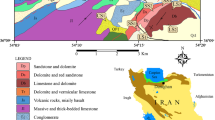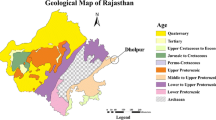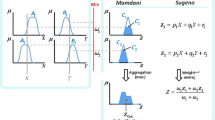Abstract
More than 35% of the earth’s crust is comprised of clay-bearing rocks, characterized by a wide variation in engineering properties and their resistance to short term weathering by wetting and drying phenomenon. The resistance to short-term weathering can be determined by slake durability index test. There are various methods to determine the slake durability indices of weak rock. The effect of acidity of water (slaking fluid) on slake durability index of shale in the laboratory is investigated. These methods are cumbersome and time consuming but they can provide valuable information on lithology, durability and weather ability of rock. Fuzzy set theory, Fuzzy logic and Artificial Neural Networks (ANN) techniques seem very well suited for typical complex geotechnical problems. In conjunction with statistics and conventional mathematical methods, a hybrid method can be developed that may prove a step forward in modeling geotechnical problems. During this investigation a model was developed and compared with two other models i.e., Neuro-fuzzy systems (combination of fuzzy and artificial neural network systems) and artificial neural network system, for the prediction of slake durability index of shaly rock to evaluate the performance of its prediction capability.





Similar content being viewed by others
References
Alvarez G M, Bruines P A, Verhoef P N W (2000) Modeling tunnel boring machine performance by neuro-fuzzy methods. Tunnelling and Underground Space Technology, 15(3):259–269
Balakrishna S, Ramana Y V (1968) Integrated studies of the elastic properties of some Indian rocks. Geophysical monograph, 12, American Geophysical Union, 489–500
Bezdek J C (1981) Pattern recognition with fuzzy objective function algorithms. New York, Plenum Press
Chiu S (1994) Fuzzy model identification based on cluster estimation. J Intelligent and Fuzzy Systems, 2(3):267–278
Franklin J A Chandra R (1972) The slake durability test. Int J Rock Mech Min Sc 9:325–341
ISRM (1972) Suggested method for deter mining water content, porosity, density, absorption and related properties and swelling and slake durability index properties.
ISRM (1981) Rock characterization testing and monitoring, ISRM suggested method. Int. society for rock mechanics: 211
Jang JSR, Suni CT, Mizutani E (1997) Neuro-fuzzy and soft computing. A computational approach to learning and machine intelligence. New York, Prentice Hall
MacKay DJC (1992) Bayesian interpolation, neural computation, 4(3):415–447
Maulenkamp F, Grima MA (1999) Application of neural networks for the prediction of the unconfined compressive strength (UCS) from Equotip hardness. Int J Rock Mech Min Sci 36:29–39
Nauck D, Klawonn F, Kruse R (1997) Foundations of neuro-fuzzy systems. New York: John Wiley and Sons.
Simpson PK (1990) Artificial neural system-foundation, paradigm, application and implementation. Pergamon Press, New York
Singh TN, Kanchan R, Verma A K, Saigal K (2001) Prediction of p-wave velocity and anisotropic property of rock using artificial neural network technique. J of Scientific and Industrial Research, 63(1):32–38, (2004).
Singh TN, Kanchan R, Verma AK, Singh S (2003) An intelligent approach for prediction of triaxial properties using unconfined uniaxial strength. Mining Engineers J 5(4):12–16
Takagi T, Sugeno M. (1985) Fuzzy identification of systems and its applications to modeling and control. IEEE. Tran. Systems, man and cybernetics. SMC 15(1):116–132
Volarovich MP and Fan (1962) Investigation of the elastic properties of rocks by static and dynamic methods at high hydrostatic pressure. Akad Nauk SSSR Ins Fiz Zemli Tr 23(190):19–24
Acknowledgement
Authors are thankful to the technical staff of the Center of Advance Studies, Rock Mechanics and Ground Control, IT-BHU, Varanasi for providing technical assistance during experimentation.
Author information
Authors and Affiliations
Corresponding author
Rights and permissions
About this article
Cite this article
Singh, T.N., Verma, A.K., Singh, V. et al. Slake durability study of shaly rock and its predictions. Env Geol 47, 246–253 (2005). https://doi.org/10.1007/s00254-004-1150-9
Received:
Accepted:
Published:
Issue Date:
DOI: https://doi.org/10.1007/s00254-004-1150-9




